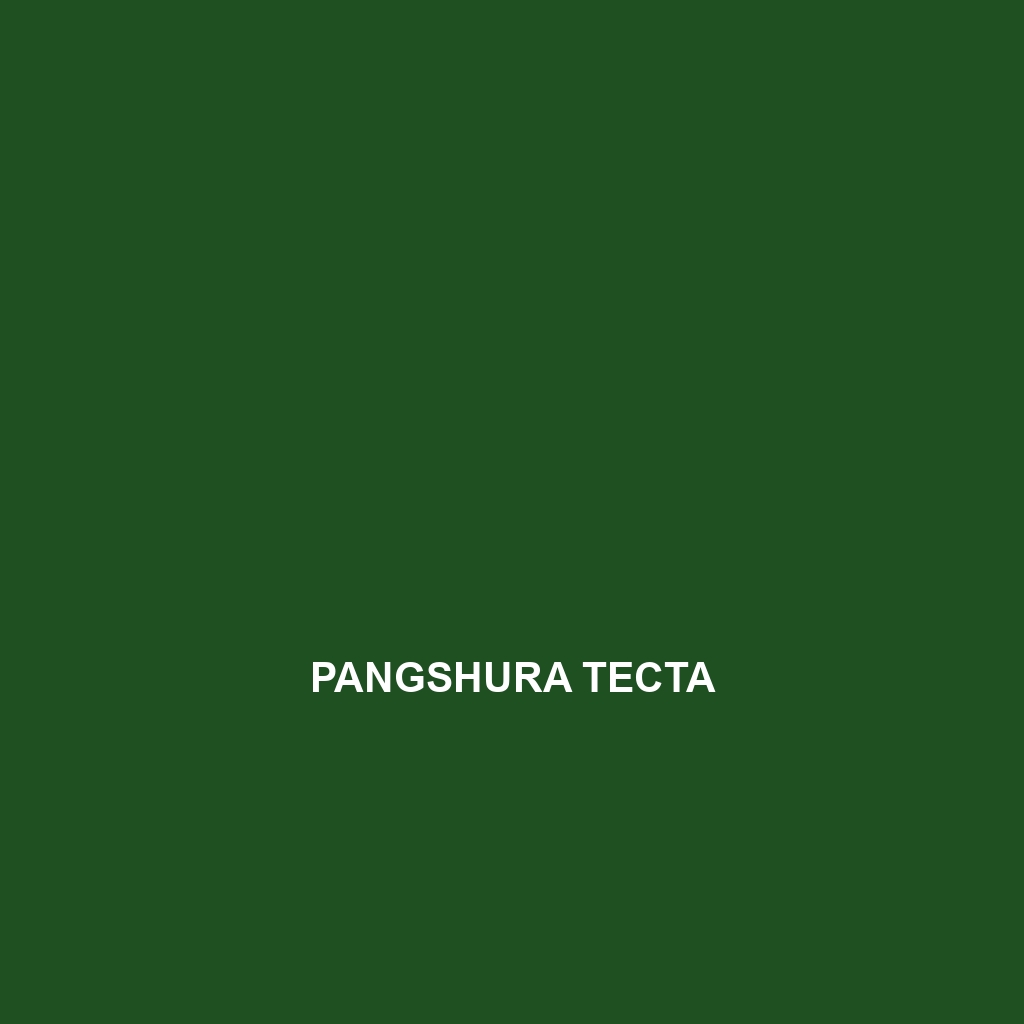Common Name
Pangshura tecta
Scientific Name
Pangshura tecta
Habitat
Pangshura tecta, commonly known as the Indian roofed turtle, is primarily found in the freshwater ecosystems of Southeast Asia. Its geographic reach extends across regions like India, Bangladesh, and parts of Southeast Asia, where it thrives in a variety of environments. This species prefers slow-moving rivers, ponds, and marshes, typically characterized by a lush vegetation cover that aids in their camouflage from predators. The climate of these areas varies from tropical to subtropical, providing the warm temperatures necessary for their activity. Additionally, Pangshura tecta is occasionally seen in the rainforests surrounding these freshwater habitats, where humidity levels contribute to their skin health and reproduction. These turtles are particularly sensitive to environmental changes, seeking out habitats where the water remains moderate in temperature and quality.
Physical Characteristics
Pangshura tecta exhibits several distinctive physical traits that set it apart from other turtle species. Typically, adults measure between 15 to 20 centimeters in carapace length. The shell, or carapace, is characterized by a smooth, oval shape adorned with concentric growth rings that indicate their age. The coloration tends to be a rich olive or dark brown, often exhibiting yellowish streaking that creates a beautiful contrast. Their underbelly, or plastron, is lighter, commonly ranging from cream to yellow. Notably, this species has webbed feet, well-adapted for swimming, and sharp claws that enable them to grasp submerged vegetation. Additionally, Pangshura tecta displays a unique pattern on the head with yellowish stripes that run from the eyes down towards the neck, which is crucial for its identification among similar tortoise species.
Behavior
The behavior of Pangshura tecta is fascinating and adaptive. Known for its semi-aquatic lifestyle, this species is primarily diurnal, actively foraging and basking during the daytime. They engage in social interactions, often seen basking in groups on logs or rocks. This turtle displays a unique mating ritual characterized by elaborate courtship displays where males often show off their vivid coloration. Pangshura tecta also has a remarkable capability to burrow into mud during dry spells, showcasing their resilience to varying environmental conditions. Their aquatic agility allows them to evade predators, often diving to great depths when threatened, and they can hold their breath for several minutes, enhancing their survival in the wild.
Diet
Pangshura tecta is primarily an omnivore with a versatile diet that includes both plant and animal matter. This species feeds on a variety of aquatic vegetation such as algae, water lilies, and various leaves that float on the water’s surface. Additionally, they supplement their diet with small invertebrates, including insects and crustaceans, which provide essential proteins. The foraging patterns of Pangshura tecta are adapted to their habitat, allowing them to graze on abundant food sources without extensive travel. Its feeding behavior contributes to the health of their ecosystem by keeping harmful algal blooms in check and supporting aquatic plant growth.
Reproduction
The reproductive cycle of Pangshura tecta typically occurs during the warmer months, with mating mainly observed during the rainy season. After a gestation period of roughly 60 to 90 days, females lay between 3 to 10 eggs in sandy riverbanks or soft mud, choosing locations that provide concealment from potential predators. The eggs are leathery rather than hard-shelled, allowing them to absorb moisture from their surroundings, which is critical for embryo development. Parental care is minimal; once the eggs hatch, the hatchlings are left to fend for themselves, relying on their instincts to navigate the complex aquatic environment immediately. The survival of hatchlings is dependent on camouflage and their ability to avoid predation during this vulnerable stage.
Conservation Status
Currently, Pangshura tecta is listed as a vulnerable species by the IUCN Red List. Factors contributing to this status include habitat destruction due to human activities such as urban expansion, pollution, and the draining of wetlands. Additionally, overexploitation for the pet trade poses significant threats to wild populations. Conservation efforts are underway, focusing on habitat restoration and legal protection to safeguard this species from further decline. Community education and involvement are critical in promoting coexistence with local populations to ensure the survival of Pangshura tecta.
Interesting Facts
Pangshura tecta exhibits several intriguing adaptations that enhance its survival. One of the most interesting is its ability to regulate its body temperature through basking during the day and seeking shade during the heat of noon. Moreover, they possess a unique self-defense mechanism; when threatened, they can retract into their shells, providing a form of natural armor. Surprisingly, they can remain submerged for extended periods, allowing them to evade predators effectively. This blend of unique physical traits and behavioral adaptations makes Pangshura tecta a fascinating subject for research within the study of aquatic reptiles.
Role in Ecosystem
Pangshura tecta plays a vital role in maintaining the ecological balance of its freshwater habitats. As an omnivore, it contributes to controlling plant populations and preventing the overgrowth of algae, which can deplete oxygen levels in water bodies. This species is also considered a crucial prey item for larger aquatic predators, including birds of prey and larger fish. By serving as both predator and prey within its ecosystem, Pangshura tecta helps sustain diverse populations in its habitat, demonstrating the intricate interdependencies within aquatic ecosystems.
